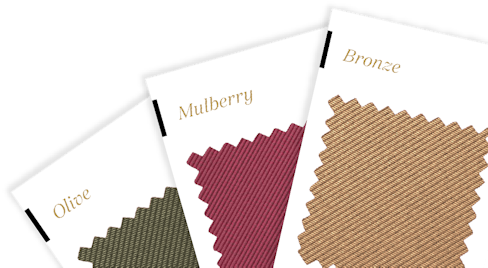What is a Lapel? Different Types of Lapels to Know

Whether you're going to prom, attending a wedding or another important event, or are the groom yourself, choosing the perfect suit that conforms to social and fashion standards is a must. Suits might seem simple, but if only one aspect is off, it could ruin the entire look.
Lapels are one of these aspects every man should be familiar with if he wants to choose the right suit for the occasion. Right now, you might be scratching your head and looking at various jackets to figure out where a collar ends and a lapel begins. By the end of this article, you'll know what lapels are, their types, how to style them, and how they came to be. You won't have to dread choosing a suit ever again.
What Is a Lapel?
A lapel is a folded flap on either side of your coat, blazer, or jacket. It's sewn underneath the collar and seems like an extension of it. Shawl lapels replace the collar entirely, but more on that later. Unless you're wearing jewelry or another item to draw attention to yourself, lapels are often the statement piece of your suit.
Lapels also say a lot about the wearer, their personal style, and what you're going for with the look. That's why it's crucial to know which type to pick and how to style them right to fit your tastes and match the current fashion standards.
The Definition of Lapel
Like many items on male clothing, lapels originate from the military. Their main purpose was to protect soldiers' necks and chests from harsh winds and cold weather. Since then, they've undergone several style evolutions, each fitting the fashion standards at the time.
Lapels have lost their functional purpose for the most part but kept their place as a decorative element of a suit. They've become smaller, however, and the flaps can be sewn onto the jacket, rarely closing up like on initial models.
The Different Types of Lapels
Today, the fashion industry distinguishes three different styles of lapels: peak, notch, and shawl lapels. All three are worn for different occasions, matched with different accessories, and look different in coordination with your partner's outfit.
Notched Lapels
A notched lapel (also known as a step lapel) is the oldest and most common lapel worn by men and women of all ages. It's characterized by the top and the bottom lapel connecting at a 75- or 90-degree angle, creating a step effect. In simple terms, it looks like someone has snipped away a piece of the jacket.
Browse Notch Lapel SuitsIt's typically the same fabric and color as the rest of the suit. There might be a straight stitch connecting the lapel to the jacket's collar, but it's not as pronounced as on a peaked lapel. Notched lapels are also generally paired with single-breasted suits. You'll rarely see them on double-breasted suits.
A notched lapel suit jacket is universal. It fits both formal and casual occasions, so you can almost never go wrong with it.
However, note that a notched lapel is less formal than other lapel types, so you might require more formal menswear in some specific situations. Fortunately, these cases usually state the dress code, so you'll know whether a notched lapel is acceptable.
Peaked Lapels
A peaked lapel is the most formal and commonly worn during white-tie events and weddings. You'll often see them in some tuxedos, tailcoats, and double-breasted suits. They add unparalleled appeal to your outfit and instantly uplift your overall appearance.
Browse Peak Lapel SuitsPeak lapel suits have defined edges pointing upwards towards your shoulders and often come in different materials and colors than the rest of the jacket. Peaked lapels are often classified as "wide lapels," considering they go above four inches.
Unless the occasion calls for it, peaked lapels should be worn sparingly. They leave a strong impression, but they can look too dressy and sophisticated for more casual events. Unless you know how to tone it down, you should skip it altogether.
Shawl Lapels
Unlike the previous two types, a shawl lapel extends from the jacket's collar rather than being stitched on. The name comes from the illusion of a shawl it creates around the wearer's neck.
You'll seldom see shawl lapels on suits, as they're exclusively reserved for tuxedos and formal occasions. Their soft round shape is usually covered in satin that complements the rest of the tuxedo (with the same satin on pocket trims, buttons, and tuxedo pants), giving an air of elegance and sophistication.
Lapel Width
Lapels are typically classified by width into slim, medium, and wide. Picking the right width depends on your height, build, and other parts of your outfit, like your tie.
Slim or skinny lapels are typically two inches wide and paired with the notch lapel type. People with a slender figure look better with slim lapels as the lapels make them appear broader in the shoulders. Similarly, slimmer ties and collars also look better when paired with this width.
Medium or regular lapels are three inches wide and quite universal. This width fits most body types, and that's why it's the most commonly found one. Medium-wide lapels are always in fashion, so you can rest assured that you won't go wrong with this option.
Wide lapels are considered everything going over three inches. Wide lapels have recently become popular, but whether they look good on you depends mainly on your body type. If you're slim, a wide lapel might "hide" you. Wider peak lapels are good for bigger guys as they'll give you a nice V-shape and accentuate your shoulders.
To show you the importance of lapel width, compare how different lapels look on a man of large stature like Jason Momoa. The self-designed burgundy suit with wider lapels looks much better than the slim black lapels on the pink velvet suit.
The History of Lapels
As mentioned, lapels originated in the 18th century from military tailcoats and frocks that buttoned up all the way to the top to protect the soldiers from cold and the wind. Indoors and during hot weather, the men would unbutton the jackets and fold them out.
As early as the 1860s, these lapels turned into a fashion statement and exchanged functionality for appearance. Double-breasted frocks with fixed lapels became a popular garment. During the Edwardian era, the frocks were replaced with morning coats which had fixed lapels that served no function but the aesthetic one.
Since then, lapels have changed with several more fashion styles and trends but still remain an important fashion detail today.
Lapels in Military Uniforms
Lapels have a different kind of role in military uniforms. They're a place for various pins denoting rank, skills, and awards. The lapels are assigned for carrying badges that show a person's branch insignia, i.e., their specific field of service and skill set. The U.S. Letters Branch Insignia should be placed on the right lapel, while the Branch Insignia Badge is worn on the left lapel.
Lapels in Formal Wear
In formal wear, lapels are nowadays merely a decoration, but they play an important role in the overall look. As a part of a suit, they're a must during job interviews, ceremonies, weddings, funerals, and other formal occasions. But they can also be worn more casually. Lapels can be adorned with various decorations that fit the occasion and prove status or qualifications.
Wearing a Lapel Pin or Flower
When it comes to suit or tuxedo must-haves, the ultimate question is whether a lapel pin is too much. Should you wear it if you wear a tie or a bowtie? Should you wear it with a pocket square, and should the color match or not? If it's a metal pin, should it be the same type as your watch and belt hoop?
The questions seem endless, and adding or excluding accessories is one of the things that can make or break your outfit.
Fortunately, you're not alone in this endeavor. The following sections will cover everything you need to know about choosing a lapel flower or pin for your suit.
Pinning a Lapel Flower
If you opt to wear a lapel flower or pin, you must learn how to properly pin it without damaging the suit fabric. Lapel flowers are worn on the left lapel around the buttonhole. If the buttonhole is functional (i.e., an actual hole), put the flower through it. Otherwise, gently pierce the fabric with the pin parallel to the lapel, as the wrong angle can ruin the look.
Choosing a Lapel Pin
Lapel pins come in different types and sizes, intended for different occasions.
Boutonnieres are real flowers, usually used during weddings and more cheerful and flashy formal occasions. Avoid them during funerals and job interviews.
Flower pins are made to mimic a boutonniere but with the advantage of being reusable and coming in various dimensions. They're worn for similar occasions as boutonnieres.
Stick pins are typically metal and go through the lapel like a needle. You can wear subtle ones at work and during job interviews to express your personal style, but make sure that they're well-coordinated with the rest of your outfit.
Mini pins and badges are attached with a clasp directly under them. They often have symbolic meanings and are used by politicians, members of certain parties, clubs, etc. With these kinds of pins, you should be careful. They're not welcome on all occasions. But if you have a pin indicating an award or certification, you can wear it during a job interview to highlight your qualifications.
Lapel pins look great with tie clips and pocket squares, so you don't have to worry about overcrowding your suit. Just ensure that you tastefully coordinate the colors with the rest of your outfit.
The Significance of Lapels
Over time, the significance of lapels has moved from providing warmth and comfort to being a fashion statement and showing one's status. However, their purpose is a bit more complex than it seems.
Lapels as a Status Symbol
Lapels have gone through several fashion changes throughout history. Rather than being a status symbol themselves, it was the way people wore them that showed their position on the social ladder. Being able to afford new looks and keep up with the latest fashion trends has always been an indicator of someone's affluence, and the same goes for lapels.
Lapels in Contemporary Fashion
Nowadays, lapels don't play a significant status role, but it is necessary to know how to find the right style and width for you and match them with the rest of your outfit. A lapel made of pure silk and looking gorgeous against your black tux will have no relevance if it doesn't fit your stature or go with your shoes.
In addition, knowing when to wear a certain lapel proves the level of your social knowledge and awareness and doesn't show you as an ignorant individual.
The Origin of the Term "Lapel"
There are two contending theories for how the word "lapel" originated. One suggests an origin from the Old English "læppa," which meant "skirt or flap of a garment," and comes from the German "Lappen" ("rag, shred") or Old Norse "leppr" ("patch, rag"). During the Middle English period, it transformed into "lappa" but kept the meaning. In the early 15th century, it added the "-et" diminutive suffix and became "lappet," meaning "lobe of a body part" before turning into "a small flap."
In another theory, "lap" as a verb meant "lay one part over another" or "lay in such a way as to cover a part of something underneath" in 1600, representing today's "overlap." Then, in the 1670s, "lap" evolved into "something coiled or wrapped up." Afterward, in 1800, the meaning of "lap" was "part of one thing that lies on and covers another," which is similar to today's meaning. The diminutive suffix "-el" was added to create the modern word "lapel."
Suit Up
Everything you've read so far should be able to help you in choosing the best lapel for your suit and occasion. At Generation Tux, you can rent your suit or tux for a wedding, prom, or any other event. We offer a free 48-hour home try-on for the groom and deliver your final look 14 days before the event.

Roshana Pourvakil
Roshana Pourvakil has been with Generation Tux since 2022, combining expertise in weddings, formalwear, and fashion with a passion for impactful marketing. She values the transformative power of suits and tuxedos, blending timeless sophistication with modern style. Her work includes leading campaigns and creating narratives that inspire unforgettable wedding moments.
Link to bio pageFeatured Products
Get started.
Stylish suits and tuxedos delivered straight to your door. See our collection and rent now.

